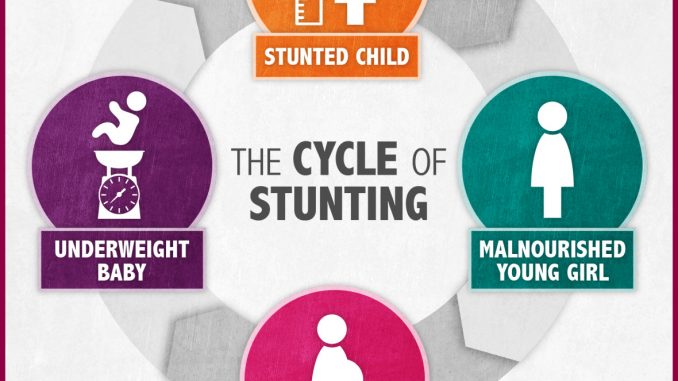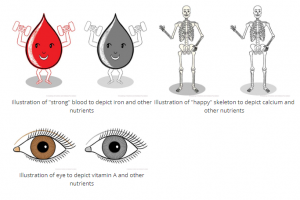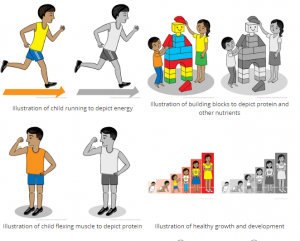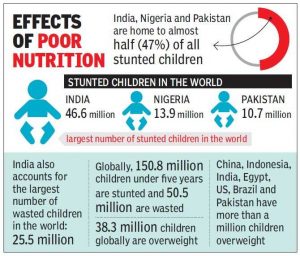
Table of Contents
Table of Contents:
- What is Nutrition?
- What is Malnutrition?
- What is Stunting?
- What are the consequences of Stunting?
- Interrelationship between Nutrition and Stunting
- Ways to Prevent Stunting
- References and For More Information
What is Nutrition?
- Nutrition is the supplement of vital elements that living organisms requires for its metabolic activities.
- Nutrition is the science of food that is absorbed by our body in result it helps in the proper functioning of the human body.
- Nutrition is the building blocks of our body and play specific roles in maintaining our health.
- In scientific terms, Nutrition refers to the intake, absorption and utilization of food in relation to our body’s dietary needs.
- Nutrition provides strong immunity mechanism and provides vital nutrients for survival.
- Food is composed of macronutrients and micronutrients.
- Macronutrients include protein, carbohydrate, and fat which are required in large quantities on a daily basis for the proper functioning of the body.
- Micronutrients include vitamins and minerals. Vitamins include water-soluble vitamins and fat-soluble vitamins while minerals include macro-minerals and trace minerals.
- The following illustration helps to understand the basic concepts of Nutrition:


What is Malnutrition?
- Malnutrition is a state that results from consuming a less or greater amount of certain nutrition.
- Malnutrition is a condition in which there is poor quality/quantity of food intake, absorption and utilization
- World Health Organization (WHO) defines malnutrition as: “The cellular imbalance between the supply of nutrients and energy and the body’s demand for them to ensure growth, maintenance, and specific functions.”
- Malnutrition encompasses both under nutrition and over nutrition.
What is Stunting?
- Stunting is a form of chronic undernutrition.
- Stunting is also known as ‘low height for age’.
- It is caused by long term insufficient nutrition intake and frequent infections.
- Stunting is the impaired growth and development that children experience from poor nutrition, repeated infection, and inadequate psychosocial stimulation.
- Children are considered to be stunted if their height-for-age is more than two standard deviations below the WHO Child Growth Standards median.
- Factors that provoke stunted growth among children include poor maternal health and diet, insufficient infant and young child feeding practices, and infection.

What are the consequences of Stunting?
- Impaired mental development
- Increased morbidity and mortality
- Prone to more infections
- Grow into adults with short stature
- Reduced earning potential in adulthood
Interrelationship between Nutrition and Stunting:
- Malnutrition (i.e. undernutrition) and stunting are directly related to each other.
- On the other hand, good nutrition and stunting are inversely proportional to each other.
- Stunting is a well-established risk marker of child poor development that has long-term effects on individuals and societies.
- The causes of stunted growth are inadequate nutrition and recurrent infections or chronic diseases.
a) Effect of nutrition on stunting:
- Chronic nutritional deficiency is one of the major causes of stunting.
- Mothers affected by undernutrition are more likely to have children who suffer from stunting or wasting. This will again continue the cycle of poverty and undernutrition (Ozaltin, Hill, and Subramanian 2010).
- In cases of stunted adolescent girls, stunting increases the risk of complications in pregnancy and delivery and also contributes to poor fetal growth.
b) Effect of stunting on nutrition:
- Stunting among children might lead them to increased risk of nutrition related chronic diseases in adult life, especially if they are accompanied by excessive weight gain.
- Stunting impairs the physical and mental development of a child. As a result, they will have reduced earning potential in adulthood which will further limit their purchasing power to afford diversified nutritious foods.
- 43 percent of children under five in low and middle-income countries are at elevated risk of poverty because of stunting (Richter, Daelmans, Lombardi et al. 2017). This will ultimately affect their nutritional status.
- As an adult, stunted children will earn 20 percent less compared to their non-stunted counterparts (Grantham-McGregor, Cheung, Cueto et al. 2007). This will increase their economic restriction for nutritious foods.
- Studies have found that adults who were stunted as children had less total schooling, lower test performances, lower household per capita expenditure and a greater likelihood of living in poverty.
Ways to Prevent Stunting:
The first 1,000 days of life – between a child’s conception and their second birthday – has been proven to be the key opportunity to prevent child stunting. Following actions can be crucial to prevent stunting among children:
- Ensure exclusive breast feeding up to 6 months of age.
- Ensure extended breast feeding along with complementary foods from 6-24 months of age i.e. at least first two years of life.
- Assure that the complementary foods, that the child receives in addition to breast milk, is adequate, diversified and nutritious.
- Provide nutrition education to mothers/caretakers and family members.
- Provide additional foods to the pregnant and lactating women.
- Carry out regular growth monitoring and nutritional assessment of the child.
- Ensure dietary diversity, fortification and supplementation in the child’s food.
References and For More Information:
Black RE, Heidkamp R. Causes of Stunting and Preventive Dietary Interventions in Pregnancy and Early Childhood. Nestle Nutrition Institute workshop series. 2018;89:105-13.
Voth-Gaeddert LE, Stoker M, Cornell D, Oerther DB. What causes childhood stunting among children of San Vicente, Guatemala: Employing complimentary, system-analysis approaches. International journal of hygiene and environmental health. 2018;221(3):391-9.
https://www.powerofnutrition.org/the-impact-of-stunting/
https://onlinelibrary.wiley.com/doi/full/10.1111/j.1740-8709.2011.00349.x
https://www.who.int/nutrition/healthygrowthproj_stunted_videos/en/
http://unicef.in/Whatwedo/10/Stunting
https://www.ncbi.nlm.nih.gov/pubmed/29991036
https://www.who.int/nutrition/topics/globaltargets_stunting_policybrief.pdf
https://www.unicef.org/zambia/nutrition
https://www.cochranelibrary.com/cdsr/doi/10.1002/14651858.CD011695/epdf/full
https://emedicine.medscape.com/article/1104623-overview